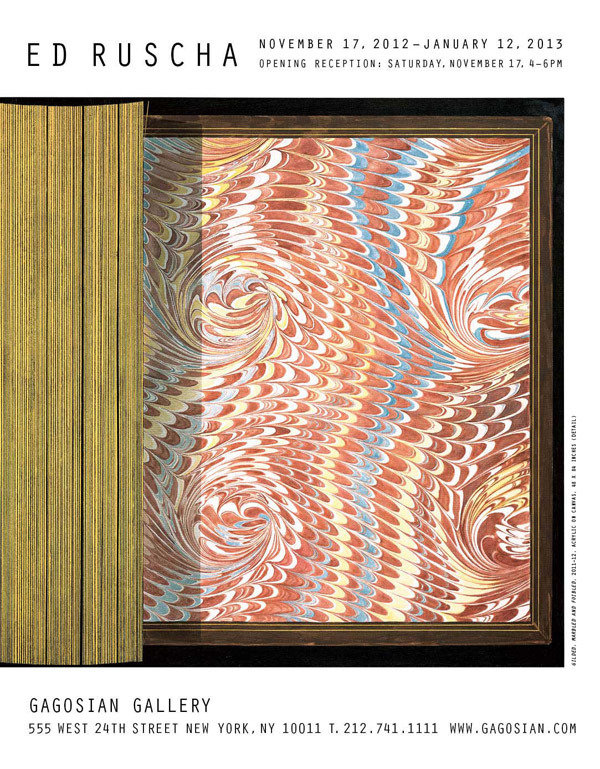Ed Ruscha
dal 16/11/2012 al 11/1/2013
Segnalato da
16/11/2012
Ed Ruscha
Gagosian Gallery, New York
After 'Reading Ed Ruscha' at Kunsthaus Bregenz, which fully explored Ruscha's obsession with books and language, here the focus is on his consideration of the book over the last 25 years as a subject, as a support for pictures, or as an actual object. It includes acrylic and oil paintings, drawings, watercolors, photographs.

Sometimes I wonder whether I am painting pictures of words or whether I'm painting pictures with words.
Ed Ruscha
Ed Ruscha's oeuvre has never been confined to established categories of style or media; for instance, books, drawings, prints, photography, and painting are used in parallel, together with materials as unconventional as gunpowder, fruit juice, bleach, coffee, and syrup. But throughout Ruscha's restrained yet daring experimentation, writing as act and subject, in print form or painted on canvas, has remained a constant inspiration for his iconic images of the American vernacular. His singular, sometimes oblique use of words allows for the exploration of the role of signifiers in language and thought, while his range of artistic means allows the act of reading to be literally manipulated as a process by which to generate meaning.
This exhibition follows "Reading Ed Ruscha," at Kunsthaus Bregenz in Austria, which fully explored Ruscha's obsession with books and language from the outset of his career. In New York the focus is exclusively on his consideration of the book over the last twenty-five years as a subject, as a support for pictures, or as an actual object. It includes acrylic and oil paintings, drawings on paper, watercolors on vellum, photographs, and book works.
In the small painting History (2005), Ruscha deflates a huge topic with an austere yet highly illusionistic side view of a rather-too-slim book spine on which the word appears. Whereas in the large-format painting Gilded, Marbled and Foibled (2011-12),he lets loose in a richly patterned description of traditional decorative bookmaking techniques, while the title provides a riposte to early Conceptual Art instruction. The Open Book series (2002-05), finely executed on untreated linen as a direct allusion to traditional bookbinding materials, appear as life-size images inviting closer perusal, while the giant works of the Old Book series present age-worn pages as monumental artifacts.
Various bookworks provide corollaries to the paintings. A strategy for a series of insidious small abstract paintings from 1994-95, where words forming threats are rendered as blank widths of contrasting color like Morse communication, resurfaces a decade later in book covers, where the oppositional actions of enunciation and erasure meet. In another book series, Ruscha has again used bleach to leach a single large initial on the colored linen covers of found books, such as a gothic M on the cover of Imaginary Gardens, or L L on two matching Shakespeare tomes entitled Twins (diptych), by which he deftly transforms one medium and format into another. In another, monochrome books mimic Minimalist objects and sport appropriately generic titles such as Atlas or Bible.
Ed Ruscha was born in Omaha, Nebraska in 1937 and studied painting, photography, and graphic design at the Chouinard Art Institute (now CalArts). His work is collected by major museums worldwide. Major museum exhibitions include the drawing retrospective "Cotton Puffs, Q-Tips®, Smoke and Mirrors," which toured U.S. museums in 2004-05; "Ed Ruscha: Photographer," Whitney Museum of American Art, New York and the Musée National Jeu de Paume, Paris (2006); and, "Ed Ruscha: Fifty Years of Painting," Hayward Gallery, London (2009, traveling to Haus der Kunst, Munich and Moderna Museet, Stockholm in 2010). "Ed Ruscha: Road Tested,"Modern Art Museum of Fort Worth, Texas (2011); "On the Road," The Hammer Museum, Los Angeles (2011). "Reading Ed Ruscha" concluded at the Kunsthaus Bregenz in Austria in mid-October, just as "The Ancients Stole All Our Great Ideas" opened at the Kunsthistorisches Museum in Vienna, an exhibition that Ruscha was invited to curate, working from the national art and natural history collections. It remains on view until December 2, 2012.
For further information please contact the gallery at newyork@gagosian.com or at +1.212.741.1111.
Opening 17 november 4-6pm
Gagosian Gallery
555 West 24th Street New York
Hours: Tue-Sat 10-6
Admission free



